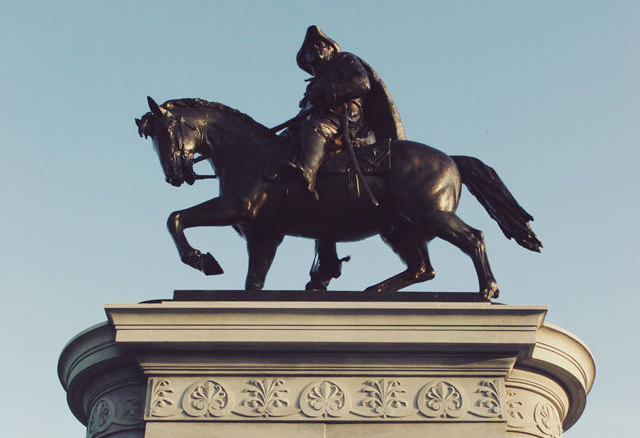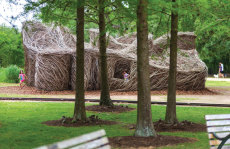If not so well-written as Sig Byrd's Houston, Jesse Ziegler's Wave of the Gulf is as vital a key to understanding local history. Where Byrd was noirish, observational, and even fly-on-the-wall in style, Ziegler's 1937 work is memoirish and gently opinionated. Ziegler was in his '80s when Wave—subtitled "Ziegler's Scrapbook of the Texas Gulf Coast Country—was published by San Antonio's Naylor Company in 1937. The book looks back as far as Ziegler can remember—all the way back to his antebellum childhood in Galveston, where he was born to German immigrants in 1857.
Ziegler moved to Houston as a 26-year-old man and was the oldest man in the Texas cotton industry by the time of Wave's publication. The book is divided into four sections: "Houston," "Tales of the Coast Country," "Historical Sketches," and "Biographical Sketches," and the Houston section is easily the best. (The book badly needed editing: Ziegler can get repetitive, and it is rife with misspellings and sports more than a couple historical inaccuracies.)
His chapter on Quality Hill -- "Houston's first residential district of the 'socially elite'"—is a true standout, showing once again that the more things change the more they stay they same, more so in Houston than anywhere else on earth.
![]()
Quality Hill is/was the shaded area.
One fine day, Ziegler was walking down Main Street near Franklin when he was picked up by a fellow octogenarian driving "a fine large sedan of the latest model." Ziegler's old friend enthusiastically exclaimed that it was "just the morning for an exhilerating [sic] drive," so Ziegler eased himself in to his friend's "sleek-looking conveyance" and they steered towards what remained of Quality Hill.
You get the impression that at one time, Quality Hill was every bit as grand as Galveston's East End or Silk Stocking District, a parade of fine old Victorian and even a few French Quarter–ish homes on streets shaded by mighty oaks. Those days were long-gone, even by 1938.
Here's Ziegler remembering the Longcope home on Chenevert, which served for a time as the HQ for Houston's first cycling club after the death of its original owner, a retired steamboat captain.
"(C)onstructed of beautiful white brick, ornamented with green shutters after the fashion of the times. It boasted also of fancy-worked, black iron railings, after the old Spanish or French styles. In its palmy days the residence stood out like a thing of beauty. Alas for the working of time! It presents now a dilapidated appearance, going slowly to ruin, and is now occupied as a Mexican rooming-house of the cheaper type."
Ziegler and friend drive down Rusk past the former "homeside" [sic] of Judge Peter Gray and that of William Baker, which served as General Bankhead Magrudger's Confederate HQ during the Civil War. Both, apparently, were already gone by 1938.
Things get sadder still when their journey takes them further along Rusk and then up McKinney.
"I recalled distinctly that in the city's earlier years those thoroughfares had been lined on either side with magnificent oaks, the towering branches of which spread across the street until they almost intermingled and it was a stirring sight to drive under the bower thus created. With the coming of the telephone and light wires, they were cut away, giving way to a progressive municipality. Yet I could not but entertain a twinge of regret at the thought of their passing."
Four more grand homes met the wrecking ball to make way for the old Post Office downtown, and now that post office's modern successor seems doomed to meet the same fate. At Caroline and Rusk there once stood the "attractive home" of rail baron Colonel Charles Dillingham, and at San Jacinto and Rusk, the "charming home of William D. Cleveland Sr."
"Alas!" sighed Ziegler. Dillingham's homesite was now a parking lot and hot-dog stand, "while that of Mr. Cleveland boasts only a parking lot." Around the corner, another grand mansion turned parking lot at the old Hutcheson place. The two men drove up Main, where "all of the magnificent home of yesteryear's Main Street are gone." A man named E.P. Hill tried to deed his old homestead to the city for use as a park, which, Ziegler wrote, "would have constituted a much needed and beautiful area." After all, a man named Captain Darling had brought back several pocketsful of acorns from the Great Oak that stood near the first capitol of Texas in Columbia and planted them long ago. By 1938, only one of these immense oaks still stood, the transfer of Hill's deed was never effected, and what could have been a downtown park was instead covered with "outmoded apartment houses and business buildings."
(So, so Houston.)
Down Main away from town stood a home that once belonged to Jesse Jones's aunt. It was "falling into decay." Captain James A. Baker's home in the 1400 block of Main? Gone, the block "filled with business buildings." "The site of the Fox home is now occupied by a prosaic appearing drugstore and other commercial buildings," Ziegler continues, after mentioning four other demolished mansions in passing. And he's not done yet: "The Major Dickson home and the James E. Masterson home have given way to a block of business houses."
Another grand home at Hadley and Milam had become a boarding house, and then we come to the former home of T.W. House at McKinney and Lamar: "It was in its day an imposing structure with the entire block covered with stately palms, neatly maintained. Until its recent demolition to make way for a used car lot, the property served as headquarters for housing Federal Transients."
The home of James Bute sported grounds and fountains comprising one of the show places of Houston. "It too has given way to the inevitable parking lot," Ziegler wrote. The James T.D. Wilson place had equally gorgeous grounds—a shangri-la of profuse flowers and shady nooks." They were bulldozed to make way for the Rice Hotel's laundry.
At last their drive came to a merciful end.
"Memories, as some writer has suggested, make life beautiful; sometimes forgetfulness alone makes it possible," wrote Ziegler. "This is a truth. The enjoyable drive—[ED: Enjoyable?]—around parts of Old Houston brought me to a realization that where we had our boyhood playgrounds, our baseball park and circus grounds—on old Bremond Square where the Lamar and Lamar Annex Hotels now stand—is now the home of cold stone and steel converted into modern sky-scrapers. Progress stops at nothing. 'The play stops at nothing...the show must go on.'"
Today, the cold stone modern sky-scraping Lamar and Lamar Annex are also gone. And both Sig Byrd's and Jesse Ziegler's essential books are many decades out of print.
This is the city that forgets even its nostalgia.


















































































